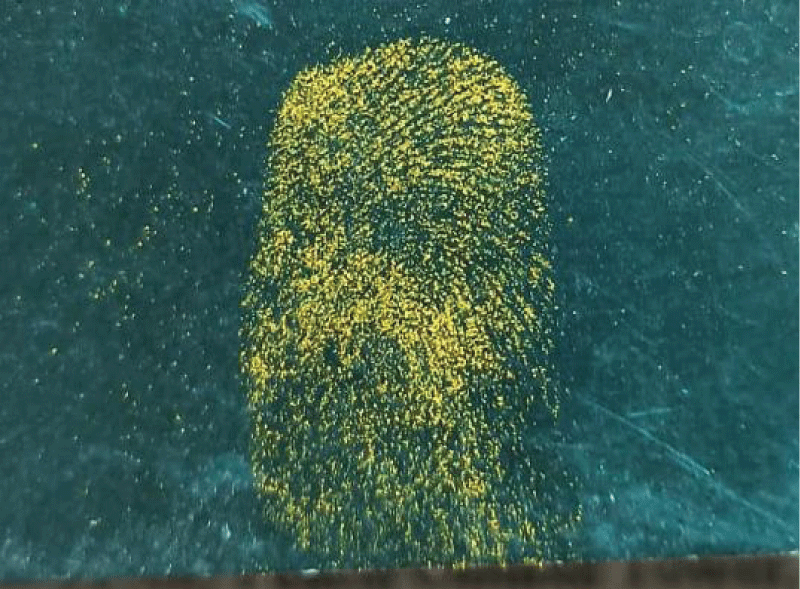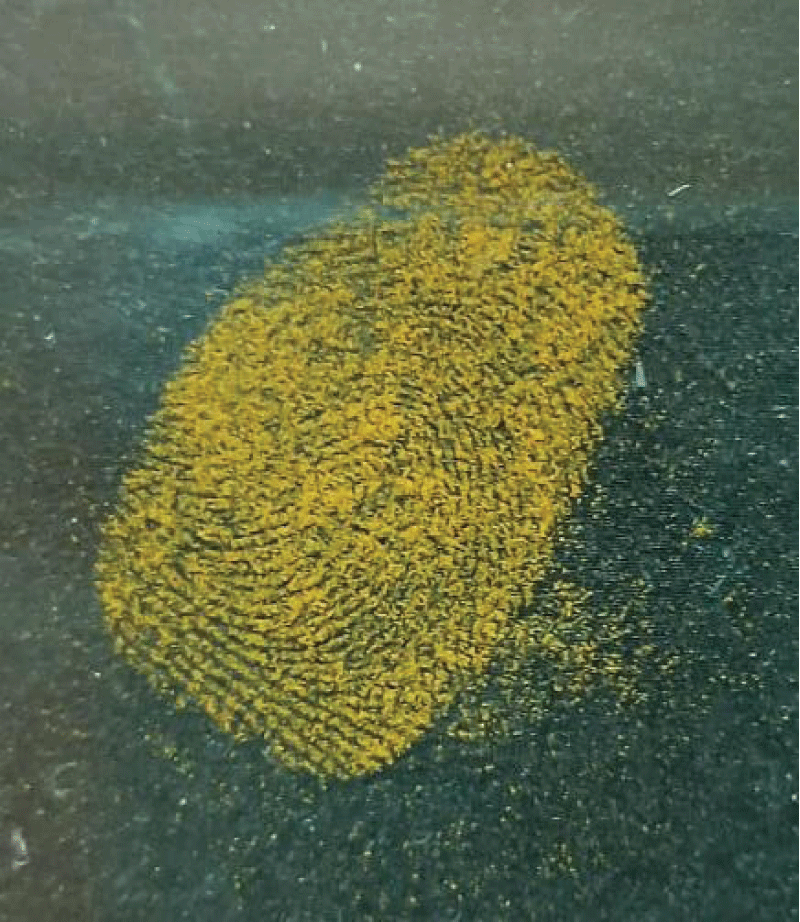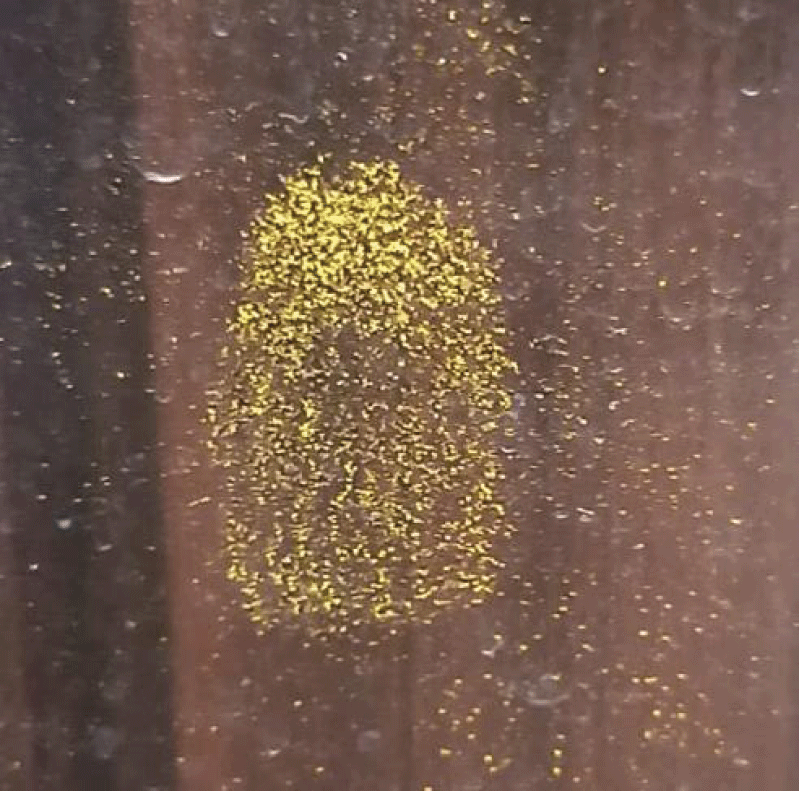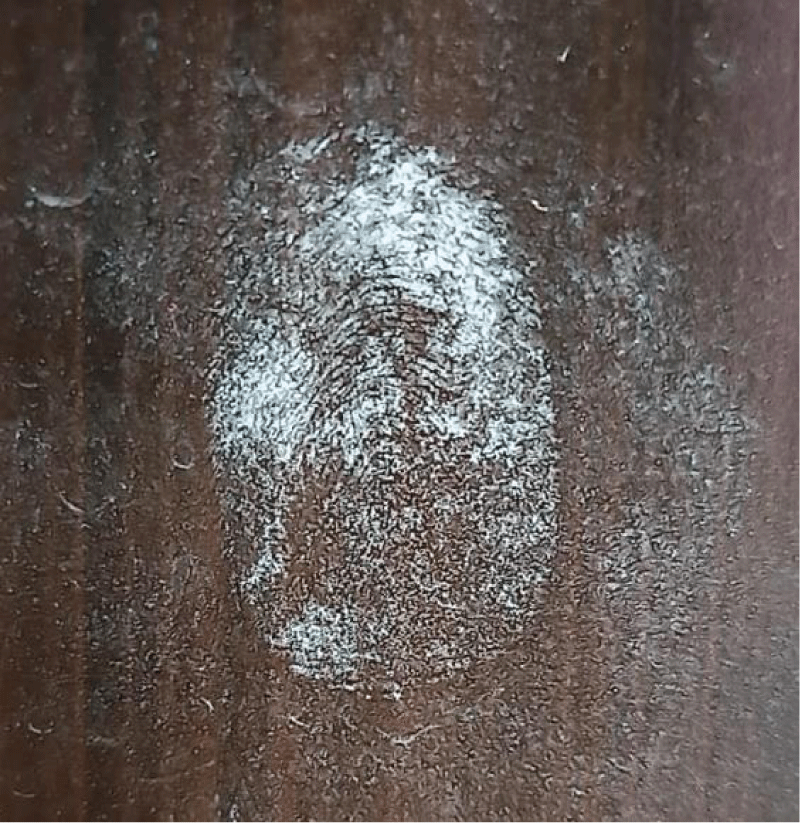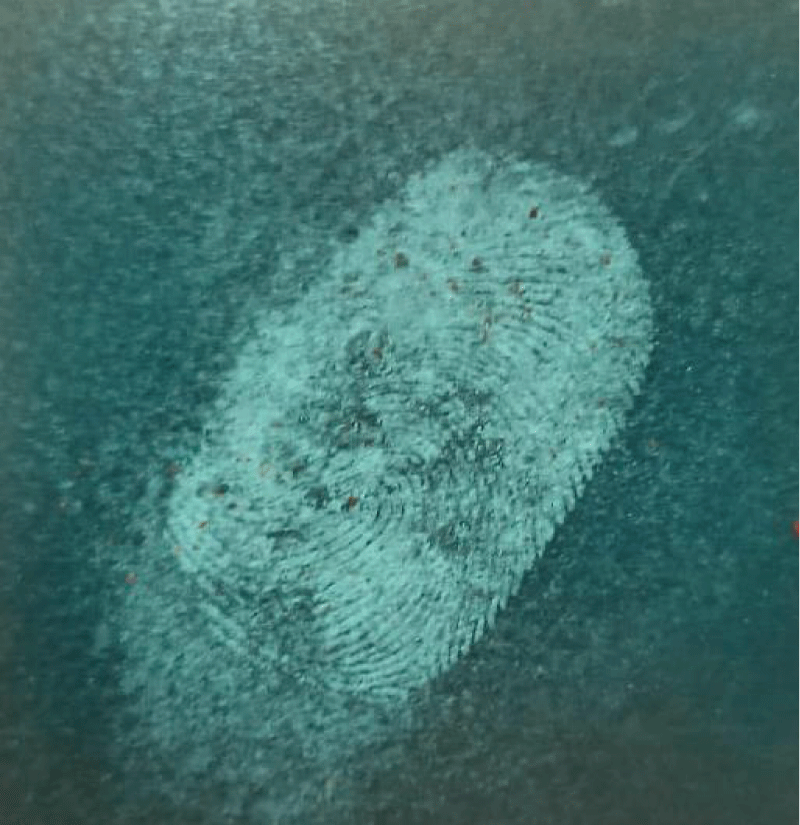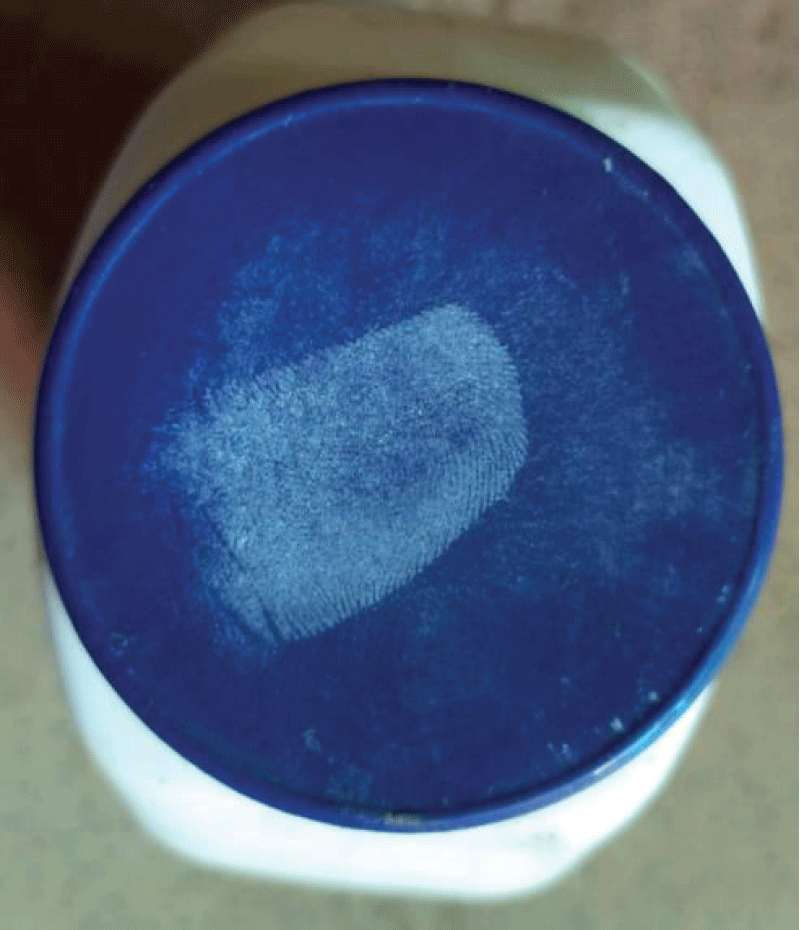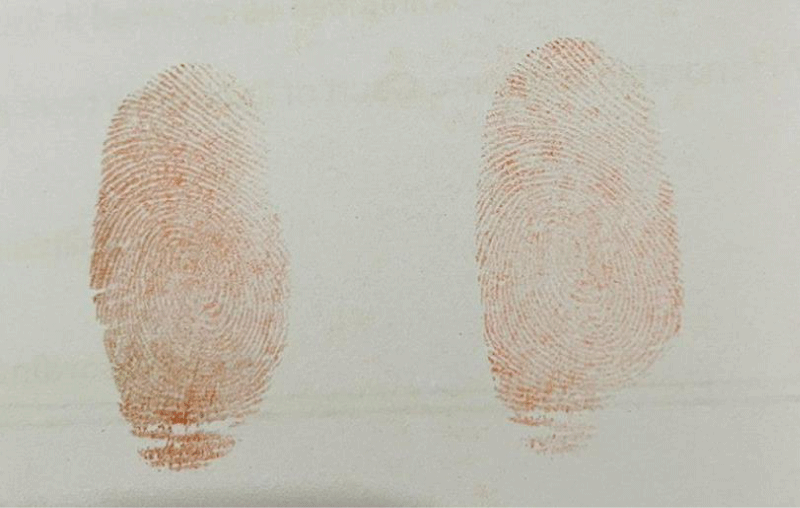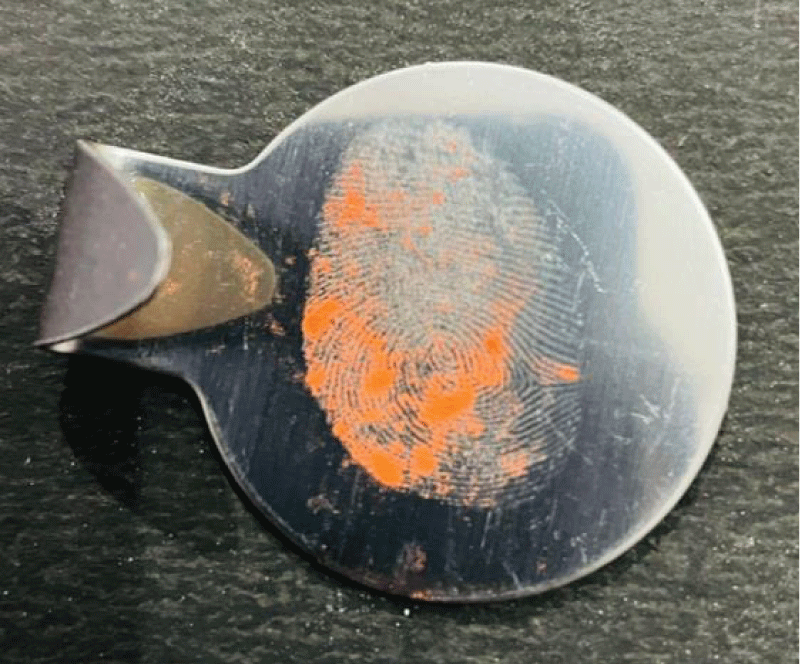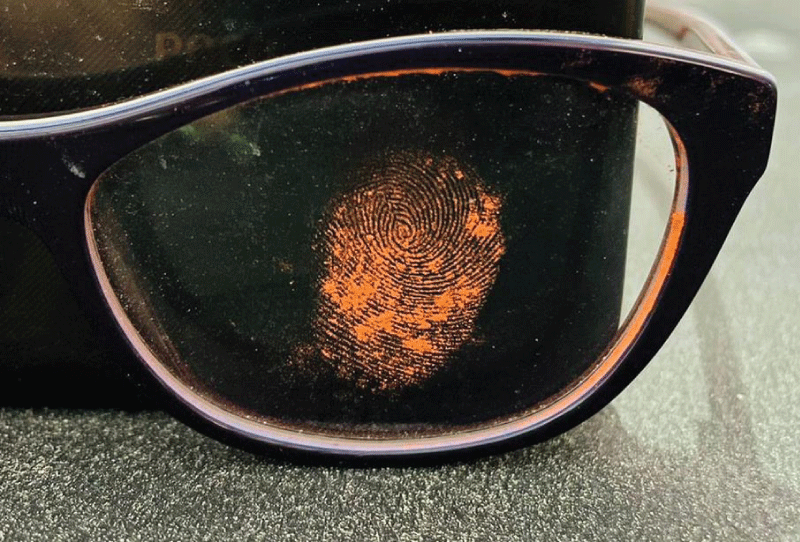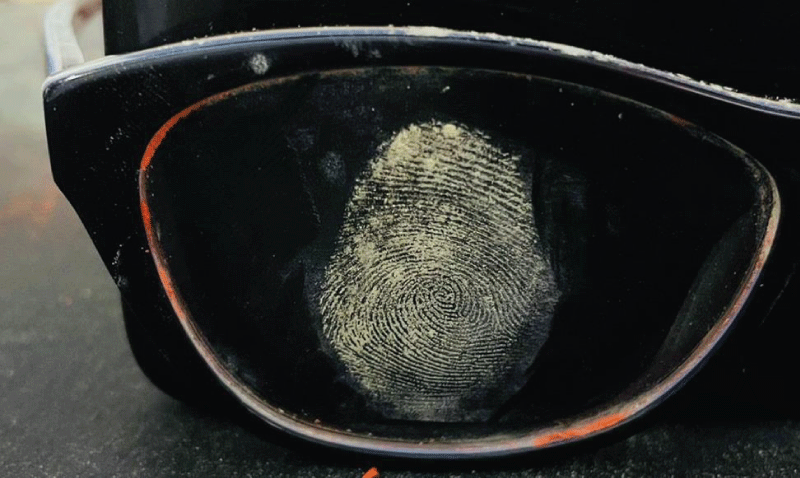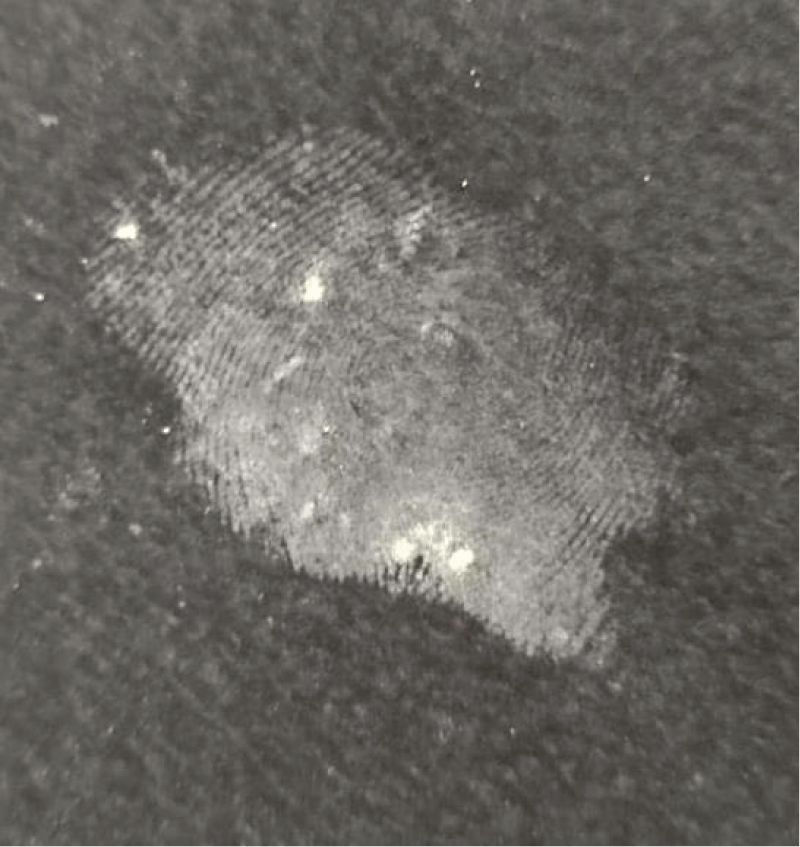More Information
Submitted: August 04, 2022 | Approved: August 22, 2022 | Published: August 23, 2022
How to cite this article: Niranjan H, Shweta R, Kapil R, Chanchal K, Rakesh M. Unconventional powder method is a useful technique to determine the latent fingerprint impressions. J Forensic Sci Res. 2022; 6: 045-048.
DOI: 10.29328/journal.jfsr.1001035
Copyright License: © 2022 Niranjan H, et al. This is an open access article distributed under the Creative Commons Attribution License, which permits unrestricted use, distribution, and reproduction in any medium, provided the original work is properly cited.
Keywords: Fingerprint; Fingerprint development; Latent fingerprint; Powder method
Unconventional powder method is a useful technique to determine the latent fingerprint impressions
Harshita Niranjan1, Shweta Rai1, Kapil Raikwar2, Chanchal Kamle2 and Rakesh Mia2*
1Banaras Hindu University, India
2Applied Forensic Research Sciences, India
*Address for Correspondence: Rakesh Mia, AFRS, President, Applied Forensic Research Sciences, India, Email: [email protected]
Background: Fingerprint development techniques are being used for a long time and are considered one among the oldest methods in forensic science used to identify suspects. Fingerprints are one of the most significant types of physical evidence. There are various types of fingerprint patterns such as visible, plastic and latent. In criminal investigation cases, chance fingerprint impressions are mostly found at the crime scene. These prints are generally invisible and therefore require several development methods. The powder dusting technique of developing fingerprints involves the application of fine powder on the impression of the print with the help of a brush such as glass fiber or a camel hair brush.
Main text: This paper rather focuses on various unconventional powder methods than the widely used conventional ones. This will help identify other cheaper, non-toxic powders that are commonly available as an alternative to the expensive, toxic ones. The author’s main aim is to provide a collective review of the work of other scientists in order to identify everyday materials, commonly available that can be used as possible means to develop a fingerprint impression.
Conclusion: For a better result, the unconventional powder is used on different surfaces i.e. porous, non-porous, and semi-porous for latent fingerprint impressions. After developing impressions on different surfaces, we conclude our result that unconventional powder is very useful.
The fingerprint is the most useful form of evidence that can be found at the crime scene. It helps in establishing the identity of the criminals. They are unique from person to person and remained unchanged during an individual’s lifetime. Based on Locard’s principle of exchange, whenever two objects come in contact with each other there is an exchange of material. At the crime scene, whenever a finger touches any object, fingerprints are left over the object because of the sweat and oil present on the skin’s surface. However carefully a criminal is to not leave any traces, yet leaves behind a set or two of latent fingerprints. In general, fingerprints can be classified as visible, plastic, and latent fingerprints [1-5]. Visible fingerprints are those prints that are visible to our naked eyes and can be easily collected. Plastic fingerprints are those prints that are left in a pliable substance such as wax, mud, clay, soap, etc. They are easily visible and need a special casting method to collect such prints. The most common fingerprints found at the crime scene are latent fingerprints. These prints are invisible to the naked eyes and require additional development methods for their visualization. These can be found on smooth and rough, porous and non-porous surfaces and the development methods which are to be used for the enhancement depends on the types of surfaces on which the prints are found.
Since the 19th century, powders are generally used to develop latent fingerprints as they easily adhere to the sweat, oil, etc present in the fingerprint. When the powder is applied to the print, it makes it visible. Over the period of time, many new techniques and powders have been developed. The most conventional methods are powder dusting, ninhydrin dipping, iodine fuming, and silver nitrate, and are commonly used for latent fingerprints development [6-8]. These methods are not always effective and suffer some limitations as the chemical contents present in them may be toxic and pose health hazards. To overcome such limitations, non-conventional powders are used as a part of the study as these are available at low cost, found in kitchens, and common households and are non-toxic thus won’t cause any harm.
In this study, non-conventional powders are used for the development of fingerprints which are generally found in every kitchen namely turmeric powder, gram powder, corn flour, baking powder, etc. These powders are available at a cheap rate and are easily available [9-15]. Fingerprints are developed on different surfaces with the help of nonconventional powders and will also be compared with the results developed using conventional powders.
All the samples are collected from different surfaces at 26 - 32 degrees Celsius. Relative humidity was moderate and sweating was low. The powder dusting method is used to visualize the latent prints. For this, we have used unconventional powders that are used by everyone in our house. When the powder is dusted over the surface, it adheres to the sweaty part of the latent prints, then the extra powder is dusted off. Then the comparative study is done based on the results obtained. The following powders are used to development of latent fingerprint impressions.
Serial no Name of Powders used
1. Talcum Powder
2. Vermillion Powder
3. Haldi Powder
5. Fuller’s Earth Powder
Turmeric (Curcuma longa): It belongs to the ginger family Zingiberaceae and is a perennial, rhizomatous, herbaceous plant. It contains a chemical known as curcumin which is used in kitchens as a coloring and favouring agent in food and for home remedies.
Vermilion (Sindoor): It is made from the powder form of cinnabar (mercury sulfide). It contains red lead and is mixed with other dyes for giving intense red colour. In India, every Indian woman uses traditional vermilion powder as it is part of Indian tradition and is found in every house.
Talcum: It is a naturally occurring mineral composed of hydrated magnesium silicate Mg3Si4O10(OH)2 and consists of hydrogen, magnesium, silicon and oxygen. It is used in every house and is found in baby powders, cosmetics, etc. It is very fine.
Fuller’s Earth (Multani mitti): It is known as bleaching clay. Hydrated Aluminium silicates are found in various proportions along with other minerals such as magnesium chloride, dolomite, quartz, calcite, and montmorillonite. It is used to treat skin problems like acne and hair problems and for various medicinal uses.
The results of the current study show that the latent fingerprints were developed using nonconventional powders on different surfaces. Some powders give better results on porous surfaces and some on nonporous surfaces. Fingerprint impressions and their ridges could be seen in Figures 1 to 11.
Figure 1: Development of Latent Fingerprint with the help of turmeric powder on Porous paper surface.
Figure 2: Development of Latent Fingerprint with the help of turmeric powder on a non-porous plastic sheet.
Figure 3: Development of Latent Fingerprint with the help of turmeric powder on the non-porous wood surface.
Figure 4: Development of Latent Fingerprint with the help of talcum powder on the non-porous wood surface.
Figure 5: Development of Latent Fingerprint with the help of talcum powder on the non-porous metal surface.
Figure 6: Development of Latent Fingerprint with the help of talcum powder on the non-porous plastic surface.
Figure 7: Development of Latent Fingerprint with the help of vermillion powder on the porous white paper surface.
Figure 8: Development of Latent Fingerprint with the help of vermillion powder on the non-porous steel surface.
Figure 9: Development of Latent Fingerprint with the help of vermillion powder on a non-porous white surface.
Figure 10: Development of Latent Fingerprint with the help of Fuller’s earth powder on the non- porous glass surface.
Figure 11: Development of Latent Fingerprint with the help of Fuller’s earth powder on the porous black paper surface.
The pigmentation and the texture of the powder used high pigmentation produced better results, also background surface used should be highly considered before choosing the powder used it should be in contrast for better visibility and proper results. The latent fingerprints impressions or invisible fingerprint impressions are identified and proper examination is positively done with the unconventional powders. The ridgeline is clearly shown in the following mentioned images and it is clear because fine particles of powder adjoining with fatty acid and oily components which is present in the sweat are deposited on the fingerprints and ridges.
Turmeric
- Paper: - A visible print was found but it wasn’t clear. The smooth surface of the paper cover prevented the particles to adhere properly.
- Plastic sheet: - A more clear and visible print was formed on the surface. The ridge pattern was visible and was easily identified with naked eyes itself.
- Polished wood surface: - The surface was extremely smooth and the particle of the powder was not at all adhering to the surface. The print was the least clear.
Talcum powder
- Polished wood surface: - The prints were not cleared but also not too vague. The smooth texture of the talcum powder facilitated the adherence of the particles which gives better pattern visibility than haldi on the same surface.
- Metal: - The print visibility was best among the samples and each ridge was easily studied.
- Plastic: The particles did adhere to the surface but the pattern came out smudged giving poor visibility.
Vermillion Powder
- Wood surface: - The print was not developed.
- White paper: - A visible and very clear print was formed on the surface. The ridge patterns were visible and can be seen and identified by naked eyes for identification purposes.
- Steel surface: - In comparison to a paper steel surface is better for ridges development. The development of fingerprints is much faster and can be seen by naked eyes.
- Glass surface: - It gives better results on the glass surface.
Fuller’s earth
- Glass surface: - On the surface of the glass fingerprints developed easily among all the samples. Each ridge can be easily identified by the naked eyes.
- Black paper: - On Black paper, the print is not visible. The smooth surface of the paper prevents the particle to adhere properly that’s why ridges are not visible.
- Wood surface: - There is little or can say no development of prints seen on the wooden surface.
It is concluded that these unconventional powders which are used to develop latent fingerprints are easily available at a low cost and are found in every Indian house. If any crime has occurred and investigation officers reached the crime scene and they do not have any fingerprint development powders, then they have easily used these household unconventional powders to develop fingerprint impressions. The uncon-ventional powders are non-toxic and very easy to use as compared to conventional powder. Even unconventional powders provide better results on surfaces for developing latent fingerprints. These powders are much more effective than conventional methods as such techniques are costly and toxic in nature.
- Garg R, Kumari H, Kaur R. A new technique for visualization of latent fingerprints on various substrates using powder from turmeric: A rhizomatous herbaceous plant (Curcuma longa). Egyptian Journal of Forensic Science. 2011; 1: 53-57.
- Nigam K, Das T, Harshey A, kumar A, Kapoor N, Yadav V, Srivastava A. Effectiveness of Talcum powder for decipherment of latent fingerprint on various substrates. Asian Journal of Chemistry. 2021.
- Thakur P, Garg R. New developing reagent for latent finger mark visualization: Fuller’s earth. Egyptian Journal Forensic Science. 2016. 6: 449-58.
- Champod C, Lennard C, Margot P, Stoilovic M. Fingerprints and other ridge skin Impressions, Chapter 4. CRC Press, Washington D.C; 2004.
- Garg RK. Latent fingerprints in forensic science. In: Veeraraghavan V, editor. Handbook of forensic science. New Delhi: Selective and Scientific Books Publishers; 2004; 77-85.
- Saroa JS, Sodhi GS, Garg RK. Evaluation fingerprint powders. J Forensic Ident. 2006; 56(2):186-197.
- Mia R, Panchal V, Gokhale C. Using Salt & Sugar Powder to Development Hidden Fingerprint Impressions at the Crime Scene. International Journal of Forensic Sciences. 2021; 6(2).
- Rohatgi R, Kapoor AK. New Visualizing Agents for Developing of the Latent Fingerprints on the Various Porous and Non-Porous Surfaces by Using Different Household Food Items. Asian Journal of Science and Applied Technology. 2014; 3(2): 33-38.
- Badiye A, Kapoor N. Efficacy of Robin® powder blue for the latent fingerprints development on the surfaces. Egyptian Journal of Forensic Science. 2015; 5(4):166-173.
- Thakur P, Garg RK. New developing reagent for the latent fingermark visualization: Fuller earth. Egyptian Journal of Forensic science. 2016; 6(4): 449-458.
- Dhunna A, Anand S, Aggarwal A, Agarwal A, Verma P, Singh U. New visualization agents to reveal the hidden secrets of the latent fingerprint. Egyptian Journal of Forensic Science. 2018; 8(1): 1-6.
- Kumari H, Kaur R, Garg RK. New Visualizing agents for the latent fingerprints: Synthetic food and festival color. Egyptian Journal of Forensic Science. 2011; 1(3-4): 133-139.
- Singh K, Sharma S, Garg RK. Visualization of latent fingerprints using the silica Gel: new technique. Egyptian Journal of Forensic Science. 2013; 3(1): 20-25.
- Ferguson S, Nicholson L, Farrugia K, Bremner D, Gentles D. A preliminary Investigation onto a acquisition of fingerprints on Foods. Science & Justice. 2013; 53(1), 67-72.
- Herschel WJ. Skin furrows of the hand. Nature. 1880; 23:76.
